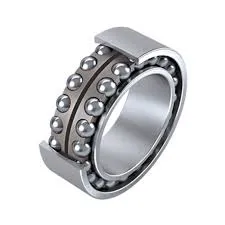
Nov . 06, 2024 08:21 Back to list
Understanding the Functionality and Applications of Cylinder Roller Bearings in Machinery
Understanding Cylinder Roller Bearings Design, Applications, and Advantages
Cylinder roller bearings are a crucial component in various mechanical systems, providing significant advantages in terms of load capacity, durability, and efficiency. These bearings, designed to support radial loads, utilize cylindrical rollers to minimize friction, making them suitable for high-load applications found in industries ranging from automotive to manufacturing. This article will delve into the design, applications, and benefits of cylinder roller bearings.
Design Characteristics
Cylinder roller bearings consist of cylindrical rollers that are placed between an inner and outer raceway. This design allows them to accommodate higher loads than traditional ball bearings. The cylindrical shape of the rollers enables a larger contact area with the raceways, resulting in better load distribution and reduced stress on the bearing surfaces. Additionally, cylinder roller bearings are typically equipped with either one row or multiple rows of rollers, which further enhances their load-carrying capabilities.
The construction of these bearings allows for easy lubrication, which is critical in minimizing wear and prolonging the service life of the bearing. Lubrication can be delivered through modern sealed or shielded designs, preventing contaminants from entering the bearing and ensuring optimal performance.
Applications
Cylinder roller bearings are utilized across a wide range of applications due to their robust design and efficiency. Some of the most common uses include
1. Automotive Industry They are frequently found in automotive transmissions, differential gears, and wheel hubs, where they support heavy loads and provide smooth rotational motion.
2. Electric Motors These bearings are essential in electric motors, ensuring that the rotor spins freely and with minimal friction, thus enhancing energy efficiency.
3. Construction Equipment In heavy machinery such as excavators and bulldozers, cylinder roller bearings support the linkages and pivot points that experience significant stresses during operation.
4. Industrial Machinery From conveyor systems to pumps and compressors, cylinder roller bearings are integral in various machinery. They are often used to support rotary motion in applications requiring high reliability.
cylinder roller bearing

5. Wind Turbines These bearings play a critical role in wind turbines, where they support the rotor and contribute to the durability and efficiency of energy generation.
Advantages
The advantages of cylinder roller bearings make them a preferred choice in many engineering applications. Below are some key benefits
- High Load Capacity The design of cylinder roller bearings allows them to handle greater radial loads compared to conventional ball bearings, making them suitable for heavy-duty applications.
- Improved Stability Their geometry provides enhanced stability when subjected to misalignment, thereby reducing premature wear and tear.
- Lower Friction The cylindrical shape of the rollers ensures a larger contact area with minimal surface contact, leading to reduced friction and energy losses during operation.
- Durability Cylinder roller bearings exhibit high resistance to wear, which translates into a longer service life. Proper lubrication further enhances their durability.
- Versatility They can be utilized in a diverse range of environments and applications, which makes them a versatile component in mechanical design.
Conclusion
In conclusion, cylinder roller bearings are a vital component in modern engineering, offering a unique combination of high load capacity, durability, and efficiency. Their robust design allows them to thrive in demanding applications across various industries, from automotive to renewable energy. As technology continues to advance, the development of even more efficient and durable cylinder roller bearings will be essential in meeting the growing demands of engineering applications. Understanding their features and benefits can help engineers and designers make informed decisions regarding bearing selection, ultimately enhancing the performance and longevity of machinery and equipment.
Latest news
-
Premium Deep Groove Ball Bearings | High Speed & Reliability
NewsAug.29,2025
-
Durable Scaffolding Clamps - Secure & Reliable Tube Connectors
NewsAug.28,2025
-
Common Failures in Thrust Ball Bearings and Solutions
NewsAug.22,2025
-
How Tapered Roller Bearings Can Take Shock Loads
NewsAug.22,2025
-
Angular Bearings in High-Precision Spindles
NewsAug.22,2025
-
The Impact of Misalignment on Cylindrical Roller Bearing Performance
NewsAug.22,2025
